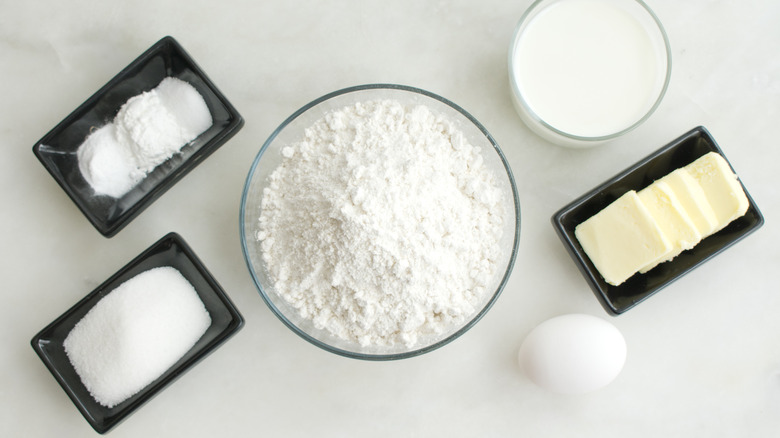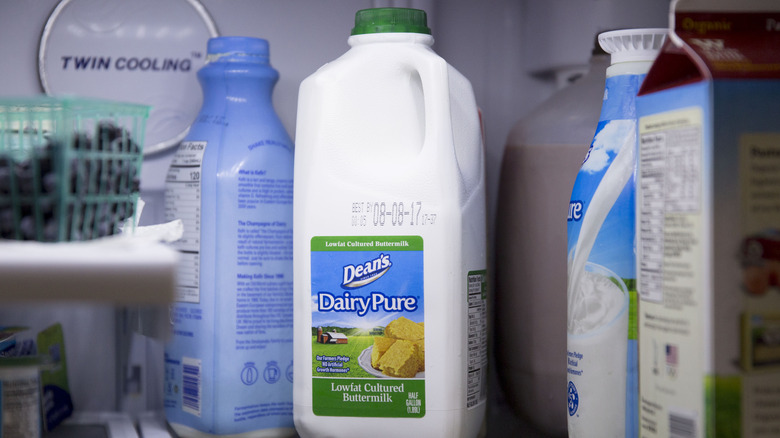Buttermilk Powder Is The Produce Dressing You've Been Looking For
Buttermilk powder is commonly used in baked goods, adding a subtle tangy flavor to biscuits, cookies, cakes, and everything in between. This often-overlooked ingredient yields the same creaminess and texture as cultured buttermilk, but it's more convenient due to its long shelf life. All you need to do is mix it with water and add it to your recipes.
Baking with powdered buttermilk is easier on the pocket and less wasteful than using the real thing. Not only will you get the fluffiest pancakes and waffles, but you'll also save some money in the long run. Plus, you can add buttermilk powder to sauces, fried chicken, mashed potatoes, soups, or salad dressings. That's right — this versatile ingredient can be a great choice for both sweet and savory dishes.
Another option is to coat fruits or veggies in buttermilk powder for extra crunch. Its slightly acidic flavor will add a refreshing note to grilled cucumbers, eggplants, baked potatoes, and more. If you go this route, you won't even need to reconstitute the powder.
How to use dry buttermilk as a dressing for fruits and veggies
Buttermilk powder might be the key to crispy baked vegetables or even fresh fruits. Simply mix it with sugar, spices, or herbs, and then use it as a coating. For example, you can dip sliced apples or peaches into a mixture of granulated brown sugar, cinnamon, and dry buttermilk. Grill or bake the fruits, and enjoy.
Similarly, combine buttermilk powder and fresh or dried herbs, such as thyme and rosemary, and then use this mixture to coat zucchinis. Pour a dash of olive oil on top and enjoy them as a snack, or throw them on the grill. For a more complex flavor, make a dressing with powdered buttermilk, mayo or Greek yogurt, garlic, fresh lemon juice, water, salt, pepper, and fresh herbs. First, you'll reconstitute the buttermilk powder by mixing it with water. After that, combine it with the remaining ingredients in a large bowl. Drizzle this mixture over salads, sliced tomatoes, veggie chips, celery sticks, or avocados.
If you're short on time, use the buttermilk powder as is. For instance, you can mix it with dried herbs, onion powder, garlic powder, and salt. Coat your favorite veggies with this mixture before grilling or roasting them. Another option is to combine dry buttermilk, lemon juice, olive oil, honey, mustard, salt, and pepper to make a tangy salad dressing. This mixture also works well as a marinade for grilled chicken or fish.
Is powdered buttermilk as good as fresh?
Powdered buttermilk is just as good as or even better than its fresh counterpart. Besides its rich flavor, it forms a thin crust around meats, vegetables, and other foods while landing a subtle tang. Moreover, it adds moisture to baked goods and tenderness to grilled meats and fish. From a nutritional standpoint, it has the same caloric value as fat-free buttermilk.
Its flavor is less acidic than that of cultured buttermilk, making it suitable for a wide range of recipes. If you taste it as is, you'll notice that it's buttery and creamy despite its dry texture. And, as mentioned earlier, it's not always necessary to reconstitute the powder. For example, you can mix it with flour or other dry ingredients and use it as a coating for grilled or roasted foods.
If you do need to reconstitute the powder, use about 25% less water than what the manufacturer recommends. The only exception is when you're making a dish where buttermilk powder acts as a binder or emulsifier, such as in these apple-cinnamon pancakes. Apart from that, it's best to use less water rather than more to prevent the buttermilk from becoming too thin.


